Community Association History
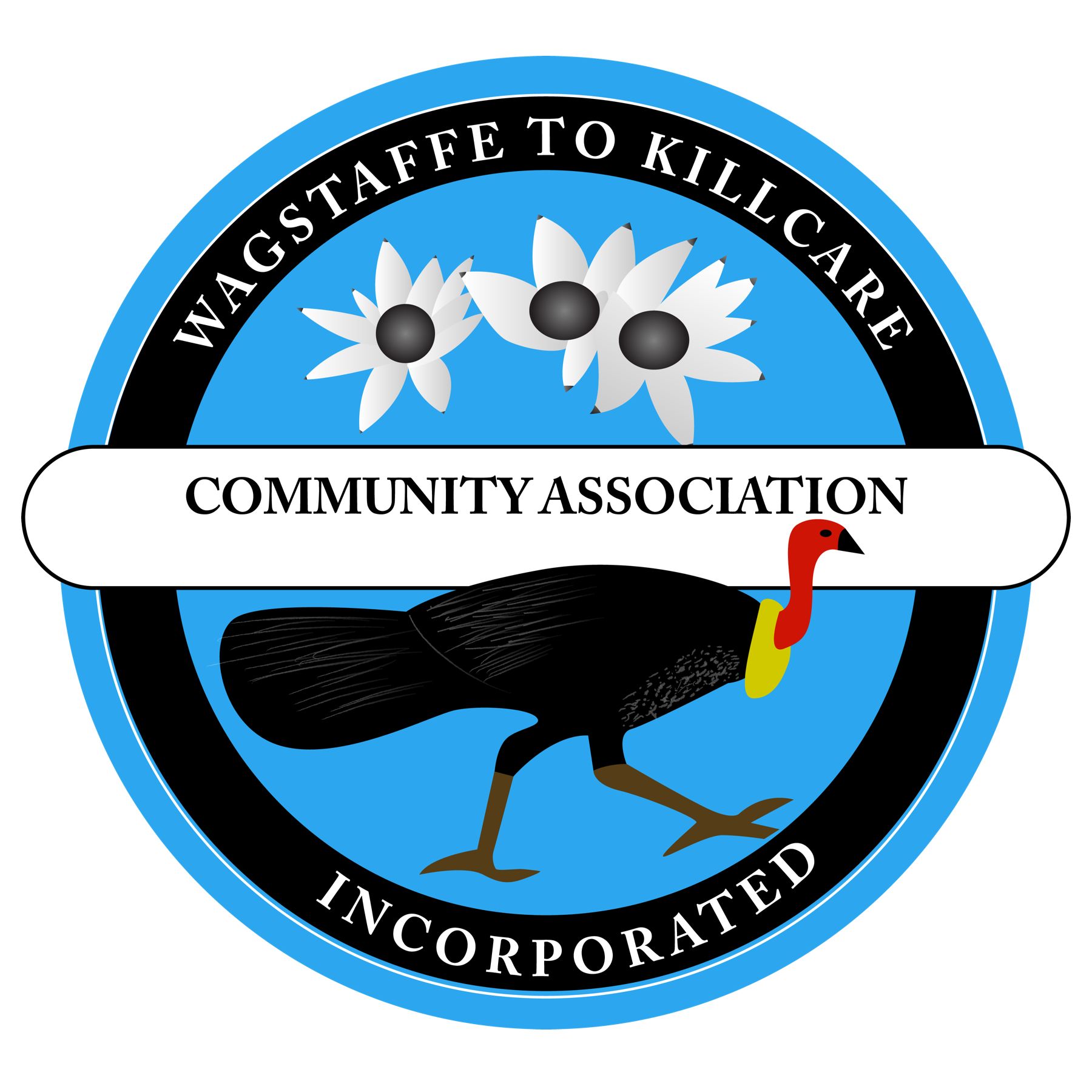
It seems that the Association has existed on the Bouddi peninsula since the early 1920s. We do not have much physical evidence of this in the form of minutes, correspondence etc. but there is mention in the history of the Pretty Beach School. An application for the establishment of a Public School at Pretty Beach Extension, together with a strongly worded letter from the Wagstaffe and Pretty Beach Progress Association outlining the reasons for the proposal, was made on the 7th January 1925. This application was the culmination of a veritable barrage of correspondence to the Department of Education from the three local Progress Associations: Wagstaff and Pretty Beach; New Bar; and Hardys Bay. Earlier requests for a school, dating from 1921, had been declined on two previous occasions. Eventually, the establishment of the school was approved by the Department of Education and the building was completed ready for its opening in 1927.
The Association has had several name changes throughout its history.
Originally the “Wagstaff Progress Association”, there was a separate one at Pretty Beach too. As quoted in Jill Baxter’s book Reflections from the Beach, Mrs Stewart remembered that the Pretty Beach and Wagstaff Progress Associations amalgamated in the little shed in Turo Park. Then, in February 1952, this combined Progress Association became known as “Pretty Beach Wagstaff Citizens’ Association” which title it retained until the AGM of 1975 when it became the “Pretty Beach Wagstaff Progress Association”.
Later, in 2007, Richard Harper – a member of the Association – led the way in pushing to change to the current title. He felt that because the Association had the licence for, and close ties with, the Wagstaffe Hall, the Wagstaffe name should come first. Interested people were asked for suggestions, and Robyn Warburton’s submission namely “Wagstaffe to Killcare Community Association” was duly accepted.
Mrs Isobell Radford, known to the children as ‘Granny Radford’, was an important person in the Wagstaffe community, and this Association, from the 1940s, and she was still attending meetings up until 1975.
In the photograph above, Granny Radford can be seen setting up tables under the coral tree in the square at Wagstaffe – in preparation for a stall, or a party. Seen here with her granddaughter, Margaret, there were often children accompanying her, as she was well-loved by the younger fry.
Rod Radford – son of Ernest and Isobel Radford – recalls the excitement engendered by the decision to build a community hall at Wagstaffe – on the site of the original home of George Wagstaffe and his family – which was also the location of the guest house ‘Manly House’ from the early 1900s until it burned to the ground in 1939.
Archival material turned up a very interesting document, namely a book, containing the Minutes of the first meetings, dating from the time the ‘Wagstaffe Hall Committee’ was formed (on November 15, 1947), and the decision being taken to build a hall. At this time the names Hanscombe, Radford, Heron, and Smith (both Digby and Frank), featured significantly in the story of the original Progress Associations, the Citizens’ Association, and the Hall Committee. These men recognised a problem existed, and were prepared to address it since, prior to erection of the Hall, people’s homes were being used for entertainment purposes. Laurie and Sylvia Heron were very hospitable and they, together with Rod and Pat Radford, taught ball-room dancing at the Herons’ house. But clearly a larger, community venue was needed.
Obviously money was needed, and it would have to come from the community. No doubt there were many street stalls, and raffles, with Mrs Radford being the driving force. Heather Milne recalls that the young women of the area were seconded to ‘buy a brick’. She remembers going from door to door convincing people to donate to a good cause. ‘This was just one of the ways the money was raised’. Jean Myer remembered that ‘housie nights helped’. She also said that Mrs Radford loaned the money for the building of the hall; whilst other people took debentures. It was also decided to hold outdoor picture shows, to help raise money.
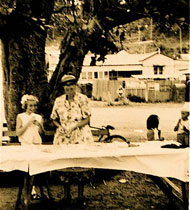
Mrs. Radford – an important community member.
The Building of the Hall
Mr Digby Smith was the President of the Wagstaffe, Pretty Beach Citizens’ Association at the time Wagstaffe Hall was built. Ern Radford, was prominent too, having been on the original committee formed to build the hall, and he continued to be a trustee for several years.
Open-air picture shows were held in Caton’s paddock – now No.75 Wagstaffe Avenue, next to where Berry’s tennis court is today – and the screen was sited adjacent to the waterfront. To begin with they had an 8mm projector, and the films came up by train from Sydney, and were collected by Bob and his taxi-truck. Bob would deliver them to Radford’s Pharmacy in Ettalong, and Rod would bring them across to Wagstaffe. A Saturday night in holiday time would see 150 or so people turn up for the pictures. Rod remembers that Rita Hayworth, and ‘shoot ’em up cowboy things’, were popular. And in inclement weather? Well, they used the Heron’s verandah.
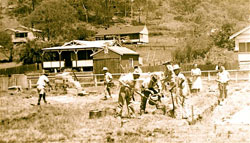
Construction work begins …
Eventually, the association had the land, and after a time they had the money too. Thus the construction work commenced in 1952. Labour was also important requirement, but they found that too. Laurie Heron* designed the building and his son, John Heron, following a visit to the site in March, 2010, kindly provided a written version of his memories of living at Wagstaffe as a small child.
John Heron recalled some of the stories, as told by his father, about the building of the hall. Laurie Heron – a member of the Association – not only designed the building, but employed the tradesmen as well. Tom Hedges of Beach Drive was to make the bricks – which were of the large ‘Besser-type’ – and the first bricklayer employed was actually a carpenter!
As told by John Heron, the story goes like this:
‘The ‘bricklayer’ started at the door (the original entrance was close to Wagstaffe Avenue) and laid a row of bricks right around the perimeter of the building; the only problem was that by the time he reached his starting point, the bricks were level with what was to be the second row. My father gave him ‘the sack on the spot’’.
John went on to say that, at that point, the Association members decided to do the work themselves. That meant that they turned up whenever they could at weekends. A supervisor, and a labourer (a young fellow from Mulhall Street), were appointed; and each section of the hall was allocated to a different man – with the width of the mortar (for each man) carefully calculated so as to result in a uniform height when the walls reached the top. So, effectively, it was voluntary labour – by men and women of the neighbourhood – that build the hall.
It is, of course, the men who can be seen in the photos from the period doing the hard labour … but the women certainly weren’t far away. The ladies would have provided the cups of tea, scones, and encouragement. Is the lady in the photo above holding a tray with glasses?
John Heron also told the story of his father’s life when he lived at Wagstaffe:
‘Laurie Heron was a draughtsman who worked at STC (Standard Telephone Cables)’. John said: “He got up at 3 or 4 a.m. and drove his flat bed truck (the one with no doors and roll-up blinds) to Gosford, and then to Woy Woy, in order to pick up ice from Woy Woy Ice-works; and he then became ‘the ice-man’ as he delivered ice around Woy Woy and Ettalong. He then left his truck at Woy Woy station, and caught the train to Sydney to work in Alexandria – where he designed STC radios. After work he would come home every night, except on Thursdays when he would stay back to do his overtime (for being late arriving in the mornings), and he would stay at his mother’s place at Hurstville. After coming home on Friday night, and having a quick tea, he was off down to the hall to put the pictures on. He was now a projectionist – not an iceman, not a draughtsman – but a projectionist, the picture-show man in living black and white’.
*Laurie Heron also designed Rod Radford’s chemist shop at Ettalong.
The ‘article’ below, found in the Association’s archives, gives us the history of the Hall – from the perspective of the unknown writer – in the days following its construction, and includes an invitation to the opening which took place in 1954. The date can be approximated as being either April or May, 1954.
….. Mission Hall and they taught the children to dance. The children then became interested in having a larger hall, so they also set to work to help raise funds for the building.
They saved their pocket money, bought sweets, rearranged them, held competitions and thereby disposed of the sweets at a great profit. They held back yard concerts; they helped at functions given by members. They also sold ‘Shilling A Brick’ tickets, and with this and funds from other functions very soon there was 150 pounds.
A member of the Association, Mr Turner, then suggested we hold an open air Picture night. Mr & Mrs Caton lent their paddock and supplied the electricity. 27 pounds was raised at this function. Expenses were high because the projector, films and projectionist were all hired. For seats at the show, we had the cement bricks with pieces of the building material laid across them; this material was later used in construction of Hall. In spite of the high expenses, the Association were inspired by the success of the evening to buy a projector of their own. At a hastily formed completely impromptu meeting, more or less on the spot, within two minutes, a sum of 90 pounds was loaned by the few present. We purchased a second hand 16 mm. projector and joined the Kodak Film Library. Two members of the Association, Mr Turner and Mr Heron operated the projector and took full responsibility for its care and maintenance.
Until the projector was bought, the Association had been struggling along in deep but moderately calm waters, but now the storm broke over the few regular members. They were accused of using ‘hole and corner’ methods to obtain the machine, the Committee was ‘unconstitutional’, so on and so forth. These howls were from people who did not belong to the Association, and many who ‘howled the loudest … did the leastest’ in every way. There was so much division of feeling that a Special Meeting of the Citizens Association was called on January 26th 1951, 8 months after the Pretty Beach, Wagstaff Association was formed. A full quorum attended, 33 were present. The results of voting on endorsing the Committee’s action, in purchasing the projector, were 31 For, 1 No Vote, 1 Against; this from a member who joined the Assoc. that morning, and who has not been to a meeting since.
The few active members kept going, the pictures were shown, in the open when fine, in private homes when cold or wet, the funds growing all the time. Soon the Assoc. was able to move to its own ground…the Village Green, where Manly House once stood. Here Mr Williamson supplied the electricity. Our grave misdemeanour was reported to the Council. However, instead of being discouraged, the Association increased its efforts and resulted in the Assoc. getting its own Electricity supply.
At a meeting on June 9th 1951, the council requested that Trustees be appointed for the Hall. They were appointed at this meeting, a lease of the ground was granted for 25 years, at 1 Pound per annum, with right to renewal at the same rate.
Given the money from the Open Air pictures, and other money-raising efforts by members and helpers, and headaches over finances and building material, it was possible to make a start on building the Hall.
The foundations were laid by voluntary labour in July 1951, 15 months after the Citizens Association was formed. The set backs and worries had been terrific, but the same few active members kept going.
Mr. Heron, a member, designed the Hall and drew up the plans, which were passed by Council. The working bees by members at week-ends contributed most of the labour, although at different times paid labour was employed. The expenses were mounting as the building grew. Members helped to put the steel principals in place to hold the roof, and finally the roof was put on; it was financed by a member and completed by mostly voluntary workers of the Assoc. The floor was laid voluntarily by members and helpers. There we wish to thank sincerely everyone who helped to do this, and also thanks to the ladies who supplied the morning and afternoon teas etc. for the workers.
The Hall was ready to use on Xmas Eve 1953, 2 years and 8 months from the time the Pretty Beach Wagstaff Citizens Association was formed. A picture show was held that night; the takings were ₤25 for our first entertainment in the new Community Hall. At this picture show, the Projector was mounted on a medium sized kitchen table at one end of the Hall and Mr Heron stood on the table beside the machine to operate it. I can assure all readers that there was still plenty of opposition.
This decided the Assoc. to hold two picture shows a week, now there was a Hall to show them in. At this time Mr Heron, who had helped so much, left the district, but still remained a member. Another member, Mr Naylor, took over the operation of the machine. After a period of this uncomfortable makeshift operation from the old kitchen table, the need of having twin Projectors was obvious, so the pictures could be shown without a break in the continuity of the picture. At the June 1953 Meeting of the Citizens Assoc. a member of the Association put forward an unconditional loan, the sum of approx. 450 pounds, the amount needed to purchase the twin projectors. For the time being the twin projectors were mounted on the red kitchen table and the shows went on. Mr Naylor was now joined by another member, Mr Bashford, to help operate the two machines.
The need of a projection room was urgent now, to house the twin projectors in a regulation fire-proof, built to standard measurements, properly equipped room. Meanwhile, the other money raising efforts were still going on in the Hall and privately: a Boys Club on Tuesday evenings, Pictures Wednesday and Saturday, Euchre for locals and visitors on Thursday evening, a dance for the young people and others on Friday evening. Then the cement projection room was built, and the machines set up properly there, Mr Naylor and Mr Bashford still taking complete charge and responsibility of machines.
To both these members we all owe our sincere thanks and gratitude, for the amount of effort in this and other ways, whereby they have helped tremendously to raise funds. We also again thank every member and helper, who has had any part in furthering the plans for the Association. The Hall is also for letting for Social Functions morning or afternoons as well. It is particularly suitable for Wedding Receptions, Smokos, Dances etc. In view of the improvements the Association wish to make, it must be realized that money is needed. The Fete, with Dance to follow, on 17th April is to help boost funds.
We are indeed privileged to have the Shire President, Councillor Brown, to make the Official Opening for us, and we invite everyone to be present at the Opening.
A further article on the activities of the Wagstaff people and our Associates, the people from Pretty Beach, will be written soon. Also a resume of the improvements to the District gained by the continued representation to the Council, to the Post Master General and others – by the Pretty Beach-Wagstaff Citizens Association.
Did I mention our population in the Pretty Beach-Wagstaff Area from the School at Pretty Beach to Wagstaff? It is 400 permanent residents.
Next article is to deal with the Charitable and other Organisations we support also, and amounts collected in our small area for same……
Unfortunately, further ‘articles’ were not found in the archives.
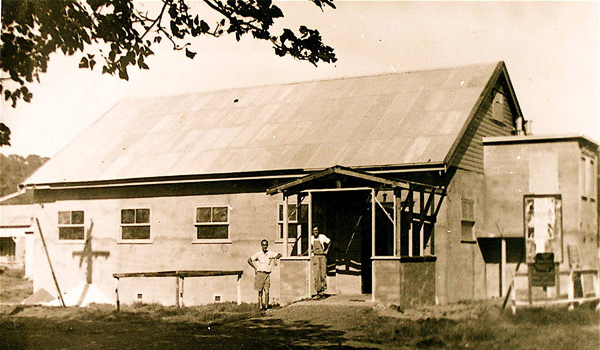
Two workers outside the Wagstaffe Hall during construction.
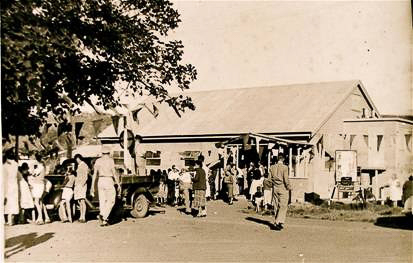
The man on the right – with his hands in his pockets – in this photograph is Laurie Heron.
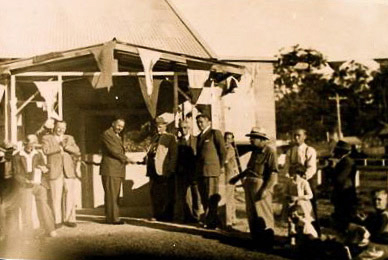
Wagstaffe Hall welcomes a crowd for its grand opening.